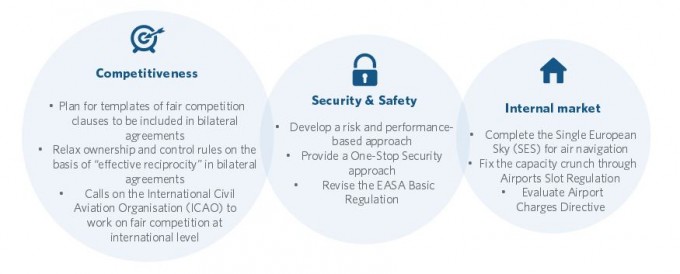The EU Aviation Strategy has landed
On Monday 7 December, the European Commission (EC) released its long-term strategy for the European aviation sector. The document touches on many elements including connectivity, competitiveness, safety and security.
The package is wide-ranging, despite the fact that the only legislative proposal contained is a revision of the Regulation on the powers of the European Aviation Safety Agency (EASA). It would in fact seem to be less a “package” of legislative measures, as the Commission had originally announced in December 2014, but rather a ‘roadmap’ for the next ten to fifteen years. This change of direction may be due to the fact that many of the actions needed for the European aviation sector are already under way with the focus being on proper implementation rather than new legislative proposals, especially on the internal market front. Alternatively, the Commission may be using the strategy to set the stage for stronger competitiveness measures in the future, responding to the rising nervousness of EU airlines towards competition from non-EU airlines.
Why does it matter to business?
The strategy does not, on first viewing, put forward concrete proposals to address some of the urgently identified needs from industry. For example, for the cost of infrastructure and the fragmentation national taxes, the Commission only proposes to work on an inventory and does not provide a timeline. The strategy might be described as a collection of good intentions and soft approaches, rather than a legislative hammer to resolve the challenges faced by European aviation. However, there are elements of significant business impact, the most notable perhaps being:
- The strategy brings forward significant proposals regarding external aviation policy, such as relaxing of ownership rules, and defensive measures against perceived unfair competition. These policy shifts will be taken step-by-step, and would seemingly indicate an effort to respond to the particular priorities of certain European airlines.
- The revision of the basic EASA regulation will impact both equipment manufacturers and their airline customers. For manufacturers, the revision should streamline some parts of the airworthiness and certification process, expanding and clarifying EASA’s competencies. However, there are areas of concern: any change to rules on environmental protection could result in stronger rules for aircraft in Europe compared to other regions of the world. For customers, the airlines who need access to certified equipment, it should result in more efficient processes and systems that result in higher safety levels.
- More flexible and proportionate safety rules can give more space to entrepreneurship and recognise the difference between various aviation sectors. In addition, with the shift towards a risk and performance-based approach, both Member State authorities and EASA itself will need to be on top of technological developments. The new regulation will interestingly give the possibility for national authorities to delegate “responsibility on implementation of EU legislation” to EASA on a voluntary basis.
- EASA looks set to acquire competence for the regulation of drones, which will be embedded in a new regulatory framework. This could represent a positive opportunity for the manufacturing sector, especially small and medium enterprises as well as for non-aviation businesses, which may be able to integrate drones in their activities.
What comes next?
- 2015: Council’s decision on mandates to the EC for negotiating bilateral agreements with third-countries.
- 2015: Revision of basic aviation safety regulation N° 216/2008 amending the powers of EASA, including introduction of provisions on drones
- 2016: Revision of Slots Regulation 549/2009
- 2016: Potential non-binding own-initiative report by the European Parliament’s Transport committee
- 2016/7: Evaluation of the Airport Charges Directive 2009/12/EC
- 2017: Evaluation of Groundhandling services Directive 96/67/EC
- 2017: Revision (Implementing act) of the air traffic management network functions, including the selection of the Network Manager
- 2019: Revision of performance scheme (gate-to-gate)
Stakeholders will likely be active in the coming months seeking to engage with the European institutions on potential future initiatives in the framework of the present strategy.
Download our assessment and summary here.
Find Out More
-
Are you fit for 2024? Communicating in a year of change
February 27, 2024



